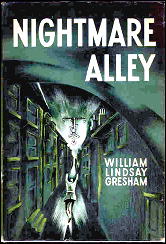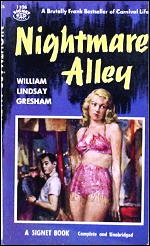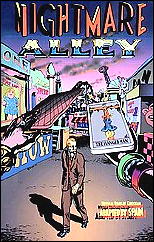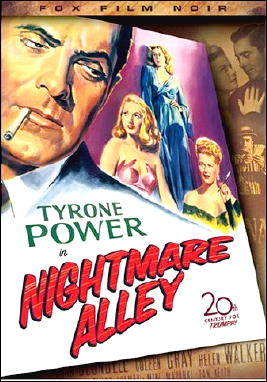Sat 17 Jul 2010
A 1001 MIDNIGHTS review: WILLIAM LINDSAY GRESHAM – Nightmare Alley.
Posted by Steve under 1001 Midnights , Reviews[21] Comments
by Max Allan Collins:

WILLIAM LINDSAY GRESHAM – Nightmare Alley. Rinehart & Co., 1946. Softcover reprints include: Signet #738, 1949, several printings; Carroll & Graf, 1986; Fantagraphics Books, graphic novel, February 2003; New York Review of Books, trade paperback, April 2010. Reprinted in Crime Novels : American Noir of the 1930s and 40s (Library of America).
Film: 20th Century Fox, 1947 (Tyrone Power, Joan Blondell; director: Edmund Goulding).
The underside of show business is given a brutal and yet somehow affectionate examination by William Lindsay Gresham in this justly famed novel. Carnival life is vividly, lovingly portrayed: “Swearing, steaming, sweating, scheming, bribing, bellowing, cheating, the carny went its way.”
Even his protagonist, Stan Carlisle, the slick, self-serving grifter, is viewed with world-weary compassion as Gresham leads him to his inevitable, much-deserved doom.

Young, ambitious Stan Carlisle has a small-time job in a traveling carnival, but by worming his way into the good graces — and bed — of mind reader Zeena, he learns the tricks of the “mentalist” trade.
Along the way he accidentally causes the death of Zeena’s dipsomaniac husband, giving him wood alcohol; and he turns the beautiful, virginal, father-fixated Molly into his mistress and reluctant partner in crime.
Though Zeena’ s tarot cards have predicted Stan’s eventual downfall, the Great Stanton rises to certain heights in vaudeville. But he is not satisfied, and involves himself and Molly in the even more lucrative “spook racket”: The Great Stanton becomes the Reverend Stanton and begins bilking the wealthy, preying upon their lost loves and buried guilts.
Then he meets and falls in love with Dr. Lilith Ritter, a psychiatrist to whom he bares his breast, and soon the seductive Lakeshore Drive psychiatrist is helping him plan one big last score.

Nightmare Alley is not a perfect book — Gresham’s poetic prose at times turns a shade of purple, and his Freudian explanations for the behavior of various characters are pat and a little dated; but few tough-guy crime novels are more powerful than this, and never have “the lower depths of show business” been explored with a more knowledgeable and sadly sympathetic eye.
Gresham, whose own suicide is foreshadowed in the suicidal impulses of several of the characters in Nightmare Alley, was fascinated with the sleazier aspects of the entertainment world.
Just as convincing as his depiction of carnival life is his inside look at the phony medium racket, which he further explored in his nonfiction work Houdini (1959).
His only other novel, Limbo Tower (1949), is a hospital tale with criminal overtones
———
Reprinted with permission from 1001 Midnights, edited by Bill Pronzini & Marcia Muller and published by The Battered Silicon Dispatch Box, 2007. Copyright © 1986, 2007 by the Pronzini-Muller Family Trust.

July 17th, 2010 at 5:17 pm
A rare example of a book and film that really compliment each other. The film is only a little less bleak and devastating than the book, and the scenes like the one where Power uses his new found abilities to out wit a small town lawman just crackle.
Gresham was, however a doomed character, which is probably why his poet wife and child left him — and went to England where she met and married C.S. Lewis.
Remarkable and powerful book, and the ending is likely to stay with you long after you turn the final page.
July 17th, 2010 at 8:32 pm
Here’s a complete list of the novels in Library of America collection, Crime Novels: American Noir of the 1930s and 40s —
JAMES M. CAIN The Postman Always Rings Twice
HORACE McCOY They Shoot Horses, Don’t They?
EDWARD ANDERSON Thieves Like Us
KENNETH FEARING The Big Clock
WILLIAM LINDSAY GRISHAM Nightmare Alley
CORNELL WOOLRICH I Married a Dead Man
That’s quite a chunk of reading, noir-style, for $35 ($23 on Amazon), and I think anyone reading this comment ought to own all six, whether in this collection, a set of paperbacks, or in the original hardcovers.
Of the six, which one’s the least well-known, would you say? My vote’s for NIGHTMARE ALLEY, but I might be wrong, and I often am.
— Steve
July 17th, 2010 at 10:42 pm
I recently reread the novel after reading a rave review by Michael Dirda of the Washington Post and it stood up to a second reading with no problem. The novel is very bleak with a depressing ending that pulls no punches. The movie is also excellent and one of the classic film noirs but Hollywood changed the ending to a more upbeat and happy one.
Steve votes for NIGHTMARE ALLEY as the least well known but I’d pick THIEVES LIKE US.
July 17th, 2010 at 11:42 pm
I have to agree with Walker in regard to THIEVES. It was certainly the hardest to find finally showing up in a fairly obscure trade paperback edition whereas the others have been in mass market editions over the years.
Nice that the Library of America have embraced the noir voice, but then things have loosened up a bit. Edgar Rice Burroughs even made it into Modern Library.
July 18th, 2010 at 9:19 am
I recently read about the controversy of including Shirley Jackson in the Library of America volumes. The argument being yes she is good but does she really deserve to be included among the great American writers.
This of course has come up before with volumes on Lovecraft and Philip K. Dick. I agree absolutely about including HPL and Dick, but I’m not sure about Shirley Jackson. Anyone else have thoughts on this matter?
July 18th, 2010 at 3:02 pm
I hadn’t heard about Shirley Jackson and the controversy you speak of, Walker, but I’ll look into it. To tell you the truth, though, I’m more surprised that the Library of America chose to do Philip K. Dick and H. P. Lovecraft before doing Shirley Jackson.
Not that I have ever read very much that Shirley Jackson wrote. I’ve tried and I never get very far. I don’t know if there’s any similarity between her fiction and say, Joyce Carol Oates, but to me they’re the same in the sense that I get the feeling that I should like them more than I do, but I don’t. (And so I’ve read little of either one, which explains why I can’t tell you if there’s any similarity between them or not!)
July 18th, 2010 at 3:33 pm
I was a little surprised when they did Lovecraft and Dick too, but for sheer influence I think they have to embrace both of them. But if you bring in Lovecraft and Dick, can you really exclude Spillane?
Re Jackson, I would have thought she would have been included long before Dick or Lovecraft. I don’t know that I would exactly compare Oates and Jackson outside of the fact they both embraced the Gothic side of American literature that has been lurking since Charles Brockden Brown and Hawthorne and into Melville. But she could almost claim inclusion based on ‘The Lottery’ alone much less THE HAUNTING OF HILL HOUSE.
I do think one thing the Library has embraced is that literary merit sometimes has to take a back seat to influence, and as they included Cooper in the 19th century I think Lovecraft in the twentieth is a natural progression. They seem to take that Library of America literally, which is lucky for us.
July 18th, 2010 at 3:47 pm
Both Jackson and Oates give me a shivery sense of unease when I read their work. I can’t explain it any more than that. Peter Straub gives me a similar feeling, not exactly the same in any of the three cases, but it’s there.
Spillane in the Library of America? I bet Max Allan Collins, who wrote the Gresham review to begin with, would go along with that!
— Steve
July 18th, 2010 at 4:57 pm
I’m presently rereading Philip K. Dick in the Library of America editions. Just finished three great novels: UBIK, THE THREE STIGMATA OF PALMER ELDRITCH, and DO ANDROIDS DREAM OF ELECTRIC SHEEP. After rereading these there is no doubt that Dick deserves to be in the series.
We have discussed this Spillane question before and I definitely do not see him as a major American writer or major crime writer. Yes, he had a big influence, that’s for sure, but he is not on the level of Chandler, Hammett, Ross Macdonald.
July 18th, 2010 at 5:08 pm
Granted it might be one of the signs of the apocalypse to many critics, but if you include Lovecraft I think you at least have to consider Spillane. And in terms of literary merit he has the same virtue as Lovecraft of being compulsively readable without a great deal of literary merit (I happen to love them both so that isn’t the knock it may sound). As a storyteller who has been a huge influence on the American scene and voice I would think he belonged as much as Lovecraft at least.
But then if you include Dick I think you have to include Robert Heinlein too — but don’t worry, I’m not going to suggest Doc Smith no matter how influential he was. You can carry a thing too far.
Sense of unease is a good description of Oates, Straub, and Jackson. In fact some of the books Oates did as Rosamund Smith are very Woolrichian in tone and subject. Oates is one of the rare writers whose non-fiction I read as avidly as her fiction.
For mystery fans, other than the Smith novels, the one to start with is the MYSTERIES OF WINTERTHURN (I think elsewhere on this blog I mixed the title with her Gothic BELLEFLEUR), a big novel whose main character is a turn of the century amateur detective. Like Ishurgo’s WE WERE ORPHANS it’s a novel rather than a detective novel, but has much of interest to genre fans. She’s also written several collections of Gothic tales well worth reading, though any reading of her should begin with the understanding she is a mainstream writer who touches on genre concerns through that.
At times I think the fact she is prolific and works in so many different voices from the Gothic to modern realism overwhelms the critics much the way Updike sometimes did. The critics like to get a writer in a nice niche and keep them there, and Oates has never been content to fit into any single niche.
July 18th, 2010 at 5:29 pm
I agree with what you’re saying about Spillane’s influence on the hardboiled crime novel, David, but I think Heinlein’s was even greater in the world of science fiction, and he was a better writer. So my vote would go for Heinlein over Spillane, if they asked me, and as Walker suggests, there really are some other PI writers I’d be happy to go along with before I thought Spillane’s time had come.
There’s no doubt about it, though. I, THE JURY completely knocked the socks off the world of crime fiction when it came out, and more!
July 18th, 2010 at 5:32 pm
When it comes to Philip K. Dick, there are few bigger fans than I, ever since the mid-1950s, when his work was coming as as the better halves of Ace Doubles. He sort of lost me toward the end of his career, but then so did Robert Heinlein.
July 18th, 2010 at 5:39 pm
Walker
I would only point out that James Fenimore Cooper doesn’t belong with Twain, Hawthorne, Poe, and Irving either, but there he is none-the-less (and Twain would not be amused). Spillane, love him or hate him, is an original voice whose books were both influential and wildly popular.
I don’t expect them to do Spillane, or want them to, but if they are consistent they may consider it.
That said, Macdonald would be far more appropriate — and probably deserving, but I’m not sure time has been as kind to Macdonald as to Spillane. Both the voice he brought to the genre and the school he founded in the genre seem to be fading fast and most of his major acolytes no longer seem to be writing.
I see a good many voices closer to Spillane than Macdonald active right now.
That said Elmore Leonard may well beat both of them to the punch since he has critical acceptance, sales, and name recognition going for him.
No question to me that Dick belongs, but I wonder if he would ever have been considered if not for Hollywood embracing his work? I was reading him well before he was ‘discovered,’ and I’m only gratified the rest of the world caught up.
July 18th, 2010 at 6:01 pm
Steve
I agree about Heinlein, and I am not advocating they do Spillane, only pointing out that based on the inclusion of Lovecraft it would be hard to make an argument against Spillane.
Where I think we are missing each other here, is that the Library of America seems to me not just devoted to literary quality, but also looking at writers whose works were both influential and popular even when other writers may have more merit. If you are going to include popular fiction then you may have to take into account that seven of the ten top bestselling books of the 50’s were written by Spillane. Much as I love Macdonald he can’t begin to compete with that.
If literary merit were the only quality Cooper would still be waiting. My understanding of the LOA is that they are dedicated to covering the best of what Americans were reading and not the best that was published. Even in this Noir anthology none of the books are obscure. If you did a survey they are the titles you probably would have gotten.
And there is precedent; a few years ago Oxford University Press had a line of books by Zane Gray, Edgar Wallace, Ouida, Marie Corelli, Edgar Rice Burroughs, and others. For that matter in literary terms you could have a tough time including Jules Verne and Dumas in French literature — but at some point you can’t ignore what the public loved and embraced — not the odd bestseller, but the writers who readers came back to again and again and again.
July 18th, 2010 at 6:17 pm
I see I left a word out in comment #9. I meant to say there is no doubt that Dick deserves to be in the series. Steve, is it possible for you to correct this for me?
In addition to Heinlein, there are other SF writers who should be considered for inclusion in the LOA series: Sturgeon and Robert Silverberg(his best work in the late 1960’s and 1970’s). Perhaps the best way to handle SF would be for a two volume anthology of novels like they did with the crime/noir novels or a collection of the very best short SF.
July 18th, 2010 at 7:01 pm
I’ve fixed your previous comment, Walker. When I read it the first time, I didn’t even notice the missing word and I knew exactly what you meant.
I’d love to see LoA do either Silverberg or Sturgeon, or even both. Luckily for either one, though, the small presses are doing a good job of keeping their work in print, along with a number of others, including Poul Anderson. So much so that I’ve fallen way behind. It’s hard to keep up!
July 18th, 2010 at 7:25 pm
Glad to see some support for Mickey.
Those who say he lacks literary merit might read the first chapter of ONE LONELY NIGHT and then submit their apologies (in triplicate please).
July 18th, 2010 at 10:02 pm
Max
I do love ONE LONELY NIGHT, and by literary merit I’m speaking more of what is sometimes called ‘fine writing’ than Spillane’s great strength — storytelling and conviction. And I would agree that he has more skill than he is ever given credit for. His voice, far from sub-literate as it is sometimes portrayed — is distinct and unique, and at his best he is simply one of the most compelling writers who ever put pen to paper. Literate and literary aren’t the same thing though.
Spillane is a skilled craftsman and a powerful voice — in that latter gift he is like Lovecraft — try as they might to imitate him he stands alone and aside from all the rest, for my money as distinct as Chandler, Cain, Hammett, or Macdonald but I don’t think his goals or achievements are the same as theirs nor do I think he intended them to be. But I do think he mastered exactly what he wanted to say and how he said it.
And how many writers with Spillane’s sales have taken the time to work at their craft and smooth out some of those rough edges? He may have lost some of the power of the early works in the process, but he became a more evocative voice and learned how to exploit the depth suggested in ONE LONELY NIGHT. He may have promoted the take the money and run image, but his work shows he never did that. A good storyteller polishes his gift as much as any literary lion.
If I distinguish between literary writers and storytellers it is because I generally prefer storytellers.
I honestly think a volume of LOA devoted to his work would be merited though I’m not advocating one.
Should they choose to do a volume of Spillane’s novels I know my choices — I, THE JURY, ONE LONELY NIGHT, THE LONG WAIT, and THE DEEP, though the first group of Hammer novels are short enough they might do all of them.
And to be perfectly clear there isn’t a lot of literary merit in Alexandre Dumas either — he’s just one of the best storytellers to ever live — not bad company for Spillane or any writer and one Spillane as a Dumas fan would appreciate.
And in case anyone wonders I also like James Fenimore Cooper, but as a storyteller, not a literary giant.
This argument always reminds me of Graham Greene telling of being at a literary cocktail party where the then literary lion Hugh Walpole was being crowded by admirers while in a corner with his famous cigarette holder sat Edgar Wallace alone. As Greene did that day, I tend to gravitate toward Edgar Wallace.
July 19th, 2010 at 3:48 pm
May I get back to WAlker’s coment on the movie version of NIGHTMARE ALLEY ?
It is, on the surface, a happier ending than the one in the book, until you stop to consider that it leaves Stanton/Power in the same role Zeena’s husband occupied earlier: a broken drunk, possessor of a mind-reading trick, supported by his woman. This role-assumption is, in fact, foreshadowed earlier in the film by a scene (not in the book) where Power uses the familiar spiel taught him by the old drunk.
Old Hollywood movies had a trick sometimes of saying one thing and hinting at another, and this is just one example.
July 19th, 2010 at 5:20 pm
I understand what Dan is saying about the so called “happy” ending of the movie. Things do definitely look bad for Tyrone Power even though his girl welcomes him back.
But the book’s ending is really so blood curdling that it makes the movie ending look “happy”. MAJOR PLOT SPOILER DO NOT READ FURTHER—YOU HAVE BEEN WARNED.
The book’s ending shows our hero as just about completely insane as he bites the heads off of chickens. This is far more bleak than the Hollywood ending. No girl helping him out in the book version.
By the way, I recently had to have the Geek Squad over to help with some computer problems and I bought this subject up concerning the meaning of the word “geek”. They insisted they do not bite the heads off of chickens…
July 19th, 2010 at 5:41 pm
Who knew Stan became Ozzie Ozborne?
But, yes, the film ends with a certain bleakness, but it is still brighter than the book. The movie ends with bleak irony, the book in horror.